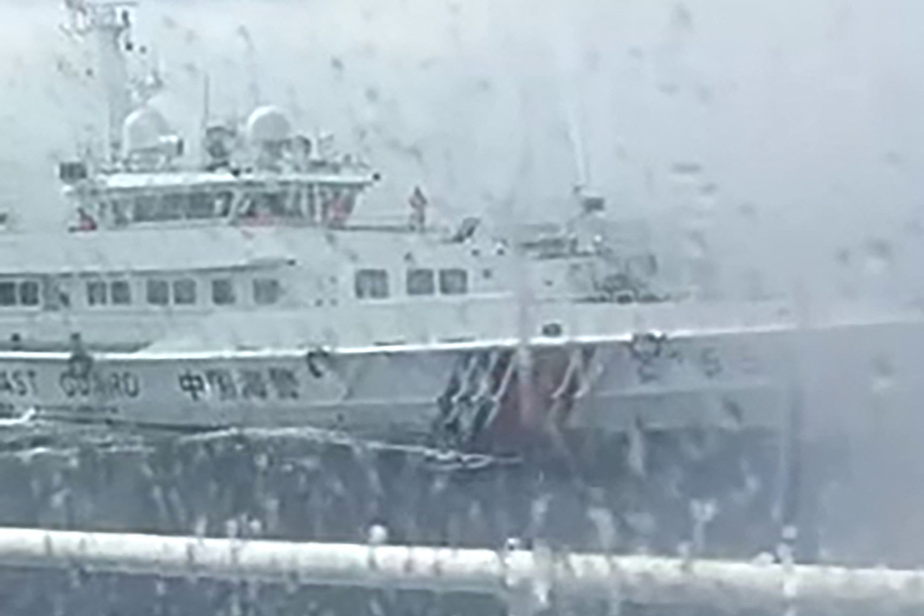(Beijing) Chinese coast guard vessels fired water cannons, blocked and rammed a Philippine Bureau of Fisheries vessel on Sunday in the disputed South China Sea, where tensions between the Asian neighbors have been rising alarmingly at sea in recent weeks.
China and the Philippines have blamed each other for the tense high-seas standoff off Sabina Shoal, which has emerged as a new flashpoint, with both countries deploying coast guard vessels amid suspicions that either could take steps to seize the uninhabited atoll.
The Chinese coast guard said it had taken action against a Philippine vessel that entered waters near Sabina and ignored warnings, leading to a minor collision.
Chinese Coast Guard spokesman Gan Yu said the Philippine ship had headed toward the Chinese Coast Guard vessel in an “unprofessional” and “dangerous” manner, causing the two vessels to brush against each other. The Philippine ship had journalists on board to take photos in order to “distort the facts,” he said.
“The responsibility lies entirely with the Philippines. We strongly warn that the Philippine side must immediately stop the violation and provocation, otherwise it will bear all the consequences,” Gan said, without elaborating on the control measures employed by the Chinese side.

PHOTO PROVIDED BY PHILIPPINE COAST GUARD, AGENCE FRANCE-PRESSE
The Chinese Coast Guard vessels, which were supported by a navy ship, “conducted close-quarters and perilous maneuvers that resulted in ramming, honking and deploying water cannons against the BFAR vessel.”
A Philippine government task force said a Bureau of Fisheries and Aquatic Resources (BFAR) vessel, the BRP Datu Sanday, “encountered aggressive and dangerous maneuvers by eight maritime vessels of the People’s Republic of China” while sailing toward Sabina, causing its engine to fail and hampering its efforts to deliver diesel, food and medical supplies to Filipino fishermen.
The Chinese coast guard vessels, which were supported by a navy ship, “conducted close and perilous maneuvers that resulted in ramming, honking and deploying water cannons against the BFAR vessel,” endangering its crew, according to the Philippine task force, which oversees territorial disputes.
“The Philippine government calls on the People’s Republic of China to stop these provocative actions that destabilize regional peace and security,” the working group said, adding that the Philippines would continue to assert its rights.
The United States has expressed support for the Philippines, its oldest treaty ally in Asia. U.S. Ambassador MaryKay Carlson said in a statement released on X that China’s actions were “dangerous, illegal and aggressive” and “disrupt a lawful mission of the Philippines, endangering lives – the latest in a series of dangerous actions.”
China is rapidly expanding its military and increasingly asserting territorial claims in the South China Sea, almost all of which Beijing claims. The tensions have led to more frequent confrontations, primarily with the Philippines, although long-running territorial disputes also involve other claimants, including Vietnam, Taiwan, Malaysia and Brunei.
The latest incident came days after Chinese and Philippine coast guard vessels collided near the Sabina Shoal, which Beijing calls Xianbin and Manila calls Escoda. Two Philippine vessels were damaged in Monday’s collision, but no injuries were reported.
Sabina Bank is located approximately 140 kilometers west of the Philippine province of Palawan, within the internationally recognized Philippine Exclusive Economic Zone.
Sabina is near Second Thomas Shoal, another flashpoint where China has obstructed the resupply of Philippine forces aboard a long-stranded navy ship. Last month, China and the Philippines reached an agreement to prevent increasingly hostile confrontations at Second Thomas Shoal.
